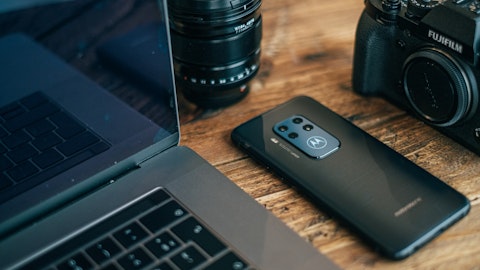Right? Now we’re moving from a pilot stage where there’s lower volumes to really mass scale. And we think in the next few years as our ramp up with Daimler Truck and market entry in the ‘26, ‘27 timeframe hits on the road, that’s where those higher volume opportunities are going to kick in. And having this capability and then that transition towards FMCW is where we see happening around this timeframe, which brings all this back together, if that makes sense.
Colin Rusch: That’s incredibly helpful. And then just outside the automotive space and the transportation space, there’s obviously a move towards trying to understand and monetize AI in the physical world, and sensors are an incredibly important part of that. Can you talk a little bit about not just with the metrology opportunity, but other opportunities that you guys are seeing coming your way now that there’s some incremental validation on the technology?
Soroush Salehian: Yes. You mean on the nonautomotive side, did I hear that right?
Colin Rusch: Exactly right.
Soroush Salehian: Yes. So absolutely. So, first of all, we have significant interest and growing momentum on the automotive side as you can see and hear from us. But that doesn’t mean that we are not doing anything on the industrial side. As a matter of fact, we are fully on track with our Nikon program later this year where that’s going to start ramping up. And we are seeing because of the fact that the core innovation of our technology being everything integrated on the LiDAR optical front into the silicon photonics module, we are utilizing that off the same technology, different software to be able to achieve very different performances like metrology and precision on other applications. So, we are engaged with a number of other folks in the industrial side to also expand on the backbone of what we’re doing with Nikon, if that makes sense.
So — and as we have more of course we’ll talk about that. But I think with what we’re seeing is with obviously advancements on robotics manufacturing, advancements with the use of AI, for both vision based as well as now point cloud based solutions that’s an area where, we think our technology could also play a role. And as we are able to use this the economies of scale with our production scale for automotive, we think that’s going to become a pretty interesting attractive product for these nonautomotive customers to be able to reduce costs while improve efficiency and automation at the factory level, especially on the manufacturing side and kind of robotic side if that makes sense.
Operator: Our next question comes from Kevin Garrigan from WestPark Capital. Please go ahead.
Kevin Garrigan: Yeah. Hey, guys. Thanks for letting me ask the question. I apologize if I missed this. I know you said you were making progress with more passenger vehicles. Have you gotten more interest from other trucking OEMs as well?
Soroush Salehian: Yes, Kevin. Happy to answer that. Absolutely, yeah. We are at this point engaged in multiple RFQs. This includes both passenger as well as commercial vehicles programs. And as I was mentioning earlier, it’s always the first win that sets the foundation for others to follow right? So, what we are hearing and we’re seeing from the OEMs is that, the Daimler Truck win really helps, derisk the decisions of the OEMs as they move from pilot to production deployments and as they make decisions to go to the next generation especially transitioning to our FMCW technology and that is across passenger as well as commercial vehicles. So, we are seeing interest in both of that. Obviously, Daimler being the marquee brand and key customer for the space, we are seeing others really interested to be able to tap into our technology for their application both in kind of high ADAS as well as automated highway applications.
Kevin Garrigan: Okay, perfect. And then kinda going off that, can you can you give us some color on the processes for both trucking and passenger cars kind of pertaining to not only the RFI and RFQ processes, but also the milestones to get to SOP are — you know, I would imagine that passenger vehicle OEMs and I may be wrong about this, but they’d be much more kind of stringent on certain tests or validation processes?
Soroush Salehian: Yeah, happy to. So overall actually, in automotive there is number of activities, there’s number of standards, there’s number of qualifications. When you deal with some of these top brands, it doesn’t actually matter I think in terms of where exactly the exact application. There is a certain level of super stringent requirements on qualification needed. For example, Daimler we had to go through significant qualification steps across our manufacturing process, quality and development teams and we were audited, right, and did that. On the trucking side commercial vehicle side actually some of the requirements on performance and reliability and shock and vibe and lifetime actually is much more stringent on the passenger car side.
So that’s why we see that enabling our technology to be really I would say think of it as mass market OEM tested and proven. And in some ways that makes it easier to also then deploy that into a mass market consumer or passenger vehicle application. But just remember that at this point as I mentioned, at this point we have done this now twice. We have completed last year earlier in the year, we introduced first time the concept of the top 10 OEM, right. And throughout the year, we provided updates. Within a few months after, within a quarter or so after, we were able to pass a comprehensive audit by that top 10 OEM. And we competed manufacturing and quality auditor. And then within six months, we won the program was production went and became Daimler and that’s when we announced that, right?
So now we are talking about a second time a new top ten passenger OEM and the time to we have done this manufacturing and quality audit by this passenger OEM is now faster than what we talked about last time. So, we are using the maturization of the company not just the product of our organization, of our team, of our processes and we’re seeing that significantly across the board, which gives us added confidence as we go towards some of the finalization of these RFQs in the next number of months.
Kevin Garrigan: Yes, that makes a ton of sense. Okay, perfect. Thank you for that.
Operator: The next question is from Suji DeSilva from ROTH MKM. Please go ahead.
Suji DeSilva: Hi, Soroush. Hi, Saurabh. So for Daimler, could you maybe handicap the opportunity to expand beyond, I guess, trucking, which is mainly North America in my — from what I can tell to additional geographies and then passenger? Just give us some sense if work’s already done and how much those could waterfall in versus what a realistic expectation is?




